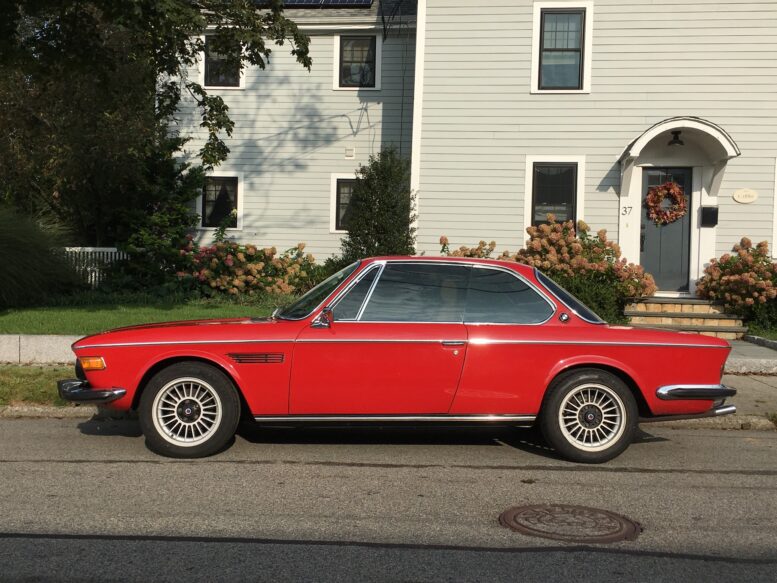I generally consider my ’73 3.0CSi E9 coupe (a.k.a. “Rene” after actress Rene Russo, whose entrance in The Thomas Crown Affair reminded me of how I’ve long described E9s as a gorgeous flawlessly-accessorized 40-something woman who turns heads when she enters a room) to be the best-sorted and most turnkey of any of my vintage cars. After it’s been sitting for months, I can reconnect the battery and it’ll start immediately (the retrofitted L-Jetronic injection doesn’t suffer from dry float bowls like carburetors), and other than checking the oil and airing up the tires, I’m good to go.
So imagine my surprise when, the day before driving to Rhode Island to deliver two talks the opening day of BMW CCA Oktoberfest, I hopped in the car (which had been sitting in the back of the garage since May), connected the battery, twisted the key, and the car lurched backward. I was lucky it didn’t slam into the wall.
Clearly, after I backed it in four months ago, I’d left the shifter in reverse. The odd thing was that when I tried to shift it into neutral, I couldn’t get it out of reverse. Even with the clutch pedal mashed firmly to the floor, I had to apply a lot of force to pull the shift lever back. But with it now in neutral, I depressed the clutch pedal again just to be certain, started the car, and couldn’t shift it into any gear with the engine running. I shut it off, tried to row through the gears with the clutch pedal depressed, and all of them felt notchy.
Slowly a thought surfaced, one that had been knocked out of my brain when the car lurched backward—I was nearly certain that I had the clutch pedal depressed when I first started the car. I mean, if I hadn’t—if the car was in reverse and my foot was off the clutch—jumping backward when the starter was cranked was exactly what it was supposed to do, but as I replayed it in my mind, yes, I was sure that my foot was in fact firmly on the clutch pedal.
So, these three clutch-depressed facts—that the car jumped backward when started with the clutch down and the shifter in reverse, that it wouldn’t go into gear with the clutch down and the engine running, and that it was difficult to shift even with the clutch down and the engine off—all hung together, and all could be explained by three different failure scenarios. From most to least likely, it could be a failure in the clutch hydraulics. Or the clutch could be frozen. Or something mechanical in the clutch release mechanism itself could be broken.
Over the years, I’ve experienced all three of these failures. They typically feel different from one another. Mechanical clutch failure is comparatively rare, but 47 years ago the clutch in my 1970 Triumph GT6+ got very difficult to depress, then I felt something break as the pedal went down, at which point it went floppy and rattly and no longer worked. On disassembly I found that the clutch pivot ball had broken through the release lever, rendering its see-saw-like design non-functional. In contrast, clutch hydraulic failure is so common on vintage cars that I include it in my “Big Seven” things likely to strand you, but it’s usually accompanied by fluid leakage and the clutch pedal going to the floor with little or no pressure. Thus, a frozen clutch seemed the most likely scenario (like disc pads sticking to rotors, the clutch disc can stick between the flywheel and the clutch plate, keeping the engine coupled to the transmission even when the clutch pedal is depressed), but the car had been in the garage, not outside, and it had only been sitting for four months, which didn’t strike me as that long. Still, it had been a very rainy summer, and the garage certainly isn’t a humidity-controlled environment.
I’d experienced traditional clutch-pedal-goes-to-the-floor hydraulic failure several times in the last few years, but I had an unusual episode in Louie, my ’72 2002tii, when it was parked at the “2002 ICON” exhibit at the BMW CCA Foundation Museum in 2018. When I was preparing to pick up Louie at the end of the show, curator Michael Mitchell warned me that the car would no longer shift into gear when running. This was surprising, as I’d changed both the clutch master and slave cylinders when I sorted out the car a year earlier. The clutch pedal felt fine. As such, I assumed the cause of the problem was a frozen clutch. The three go-to methods for breaking the corrosion and freeing a stuck clutch are a) cranking the starter with the car in gear and the brake pedal mashed, b) jacking up the rear of the car, putting it in gear, revving up the engine and spinning the rear wheels, and having someone suddenly lower the jack, and c) spraying brake cleaner down the timing inspection hole in the bell housing. I tried all three of these on Louie. None of them worked. It wasn’t until I crawled under the car and watched the clutch slave move the release lever while someone pushed the clutch pedal down that I saw that the clutch slave moved, but retreated while the pedal was still down, ergo it was a hydraulic issue. The video of this can be seen here. Replacing the year-old slave didn’t fix it, so I had to replace the year-old clutch master cylinder. Here’s the video of the correct motion once the system was repaired.
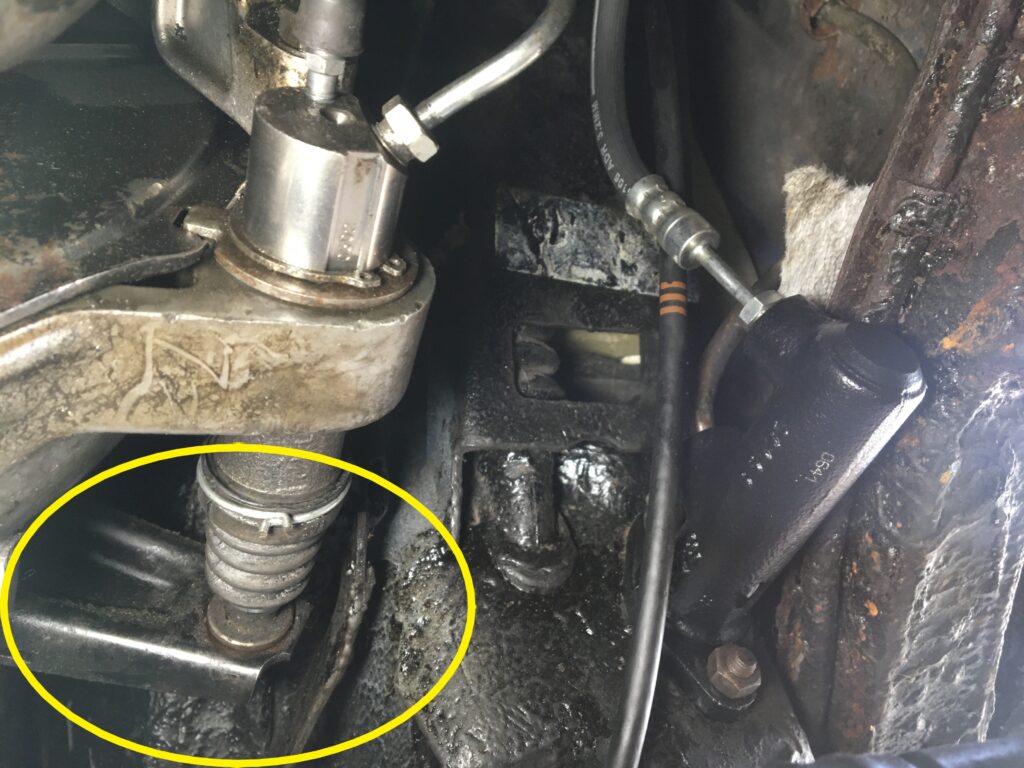
As you can see, one advantage of the stock four-speed gearbox on a 2002 is the fact that the clutch release lever protrudes through the side of the box, so you can directly eyeball the action of the clutch slave cylinder as well as the effect it has on the release lever.
Getting back to my E9, Rene has a 5-speed Getrag 265 box which has the later-style slave cylinder that’s mounted on the side of the transmission and moves a release lever that’s wholly inside the bell housing, so unfortunately, unlike on a 2002, the motion of the release lever is completely obscured.
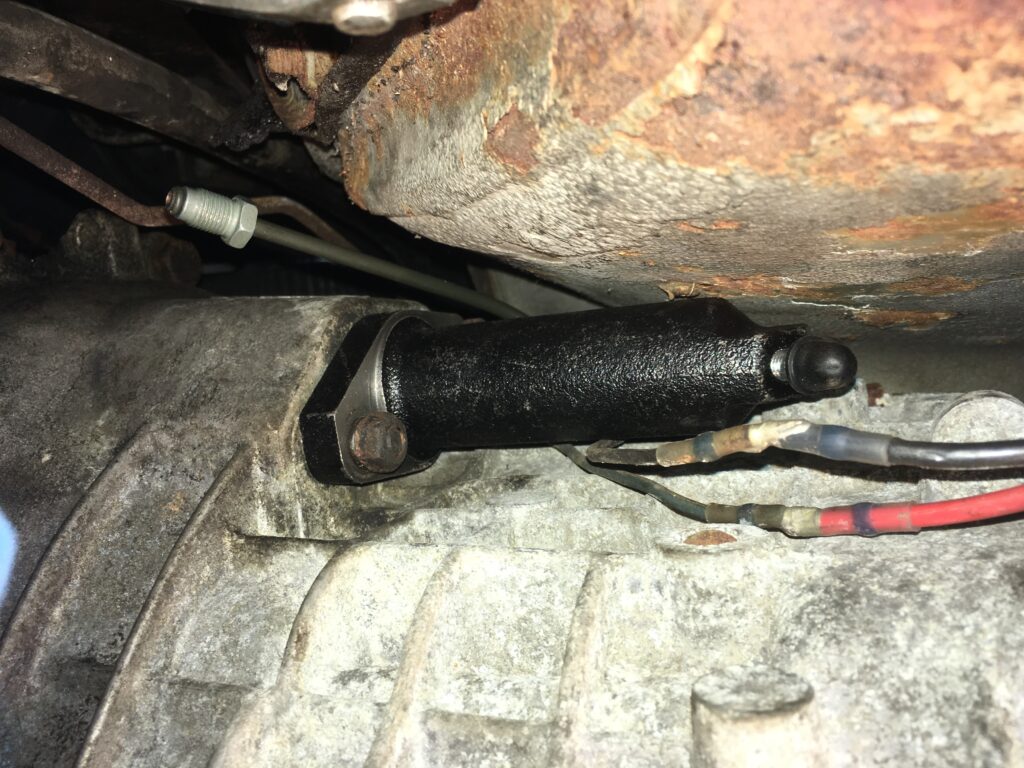
This is a slave cylinder on a Getrag 245 five-speed in a 2002, not the 265 box in my E9, but it shows how the later clutch release design has the rod from the slave cylinder going into a hole in the bell housing, hiding the mechanical motion from your direct observation.
Rene’s brake/clutch fluid reservoir was full, and I didn’t see any brake fluid under the transmission, but I never saw those symptoms with Louie either. It occurred to me that, without being able to directly observe the slave cylinder moving the clutch release lever, there’s no definitive way to tell a seized clutch disc from bad hydraulics—again, you’d expect that if the hydraulics were bad, you’d feel it in the pedal, but as per the videos above, that wasn’t the case with Louie. I bounced the question off a professional BMW mechanic friend, and he couldn’t think of a way to differentiate between them either, but if the pedal felt fine, his money was on a stuck clutch.
I’ve experienced frozen clutches twice in the last 40 years. Once was the Z3 after a winter-long sit. It freed up easily by starting the car in gear with the shifter in neutral, the clutch down, and the brake pedal pinned. I tried this half a dozen times with Rene, but had no success in first or second gear. The other time was in a long-dormant 2002 I’d bought. That one succumbed to the trick of blasting brake cleaner down the timing inspection window in the bell housing and letting it seep between the clutch and flywheel. I resolved to similarly soak Rene, but to my stunned surprise, I didn’t have any brake fluid in the garage (I know, right?).
Okay, so clutch hydraulics. I jacked up the car, set it on stands, crawled under it, inspected the clutch slave, and saw no signs of leakage at all. Remembering the episode with Louie, I knew I couldn’t directly see the clutch release lever, but I wondered if I could at least watch the motion of the rod in the clutch slave cylinder. I unbolted the slave from the gearbox and had my son Ethan gently depress the clutch pedal while I held the slave’s rod against the side of the transmission to simulate the press-back from the clutch springs. I didn’t know what the travel spec was on the slave, but the rod moved out roughly an inch and didn’t shrink back like the one in Louie did, so there was nothing obviously wrong with the hydraulics. I planned to run out and buy brake cleaner after dinner, but I got comfy with my wife in front of the television instead.
In the morning, I thought I’d try one more time to break it free before running out to Autozone for brake cleaner. I put the car in neutral, verified that it started, then this time with the car in third gear, mashed the clutch and brake pedals, and cranked the starter. The frozen clutch broke free.
Whew!
Unfortunately, when I tried to start the car, it cranked and caught, but as soon as I turned the key back from start to run, it died. It wouldn’t stay running even if I held open the throttle. I checked for popped-off connectors and vacuum hoses and found nothing. And I needed to leave for Oktoberfest in a few hours.
So much for Rene being “turnkey.”
Alert readers will note that the wants-to-run-when-cranking-but-dies-when-key-is-turned-back-to-run symptom is essentially identical to the one which recently affected Louie that I wrote about it last week in “The Entangled Roundies,” though on Louie it would appear when the car was hot. Was it an intermittent ignition switch? A bad relay? I didn’t know. I never got to the bottom of it. To continue to drive Louie, I kept a jumper wire handy so I could hot-wire the “+” or “15” side of the coil to battery positive.
If I were to wager with Rene, I’d bet that all the in-gear-brake-on starter cranking angered something up. Rene is a 3.0CSi, but the original D-Jet injection was replaced with an L-Jetronic system out of an ’81 E12 528i. It also has the 528i’s electronic ignition system. So the electrical components, while primitive, are more complicated than that on Louie the tii, whose mechanically-injected engine will run with power on just two wires (fuel pump and coil). The nightmare scenario with Rene always has been having the car dead in the breakdown lane with a no-spark or no-squirt situation, no obvious cause, and a 40-year-old ECU or electronic ignition module sure as hell not available at Autozone.
Nevertheless, I tried the same coil-hot-wiring trick with Rene, and she started. I had a closer look at the ring connector on the “+” coil terminal, and could see that there was some motion of the wire inside the crimp. I cut off the old connector, stripped the end of the wire to expose fresh copper strands, and crimped on a new connector, and the car again fired up. I shrugged and moved Rene out of the garage and in front of the house so I could load it up with books to sell at my talk.
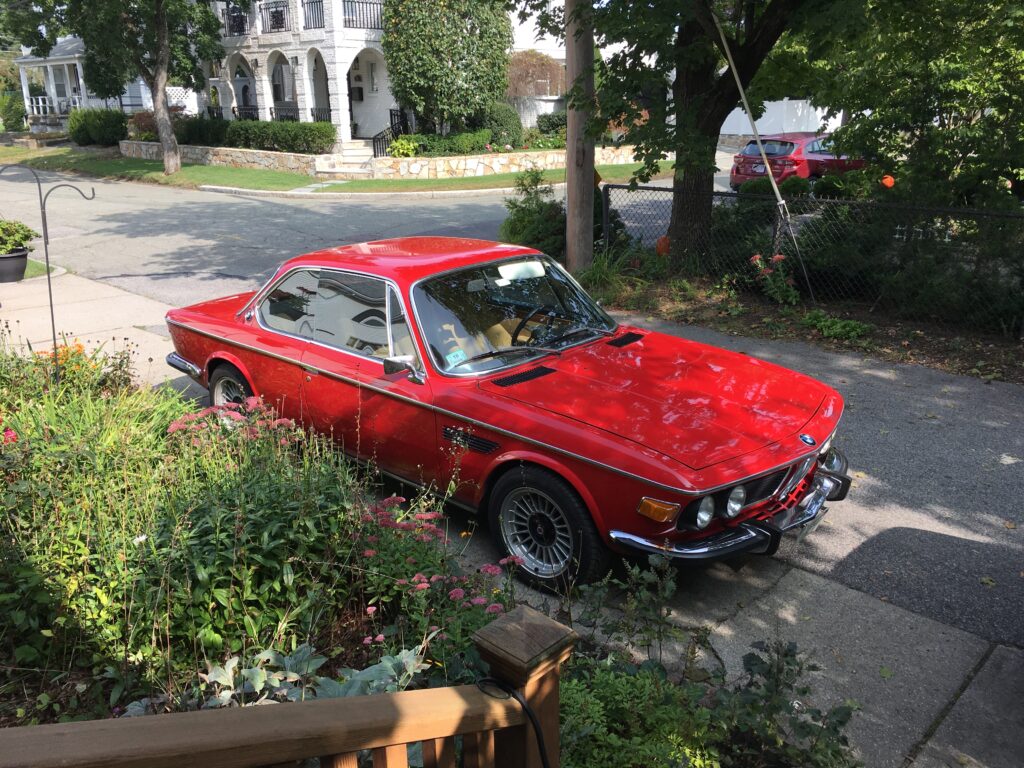
I never get tired of seeing this view when I open up my front door.
Ready to go, I hopped in gorgeous Rene, turned the key, and the car cranked but wouldn’t start.
Hmmmmn.
Now, I had lovely Hampton the survivor ’73 2002 at the house, as well as the clownshoe, and of course the daily-driver E39 530i stick sport, so I was rife with options. But it was a picture-perfect fall day, Oktoberfest in Rhode Island was only 70 miles away, and I was itching to show off Rene.
So I did what any rational person would do in this circumstance—I jumped onto Hagerty’s website and increased my policy’s towing insurance from 20 miles to 100. (Okay, truth be told, I couldn’t see a web option to change the covered tow distance; I needed to call Hagerty on the phone.) I threw my standard travel tool box and a multimeter in the trunk. And as I did with Louie, I kept a jumper wire with the proper connectors at both ends in the well under the wiper motor just in case. But I didn’t need it. I had a flawless drive down and back.
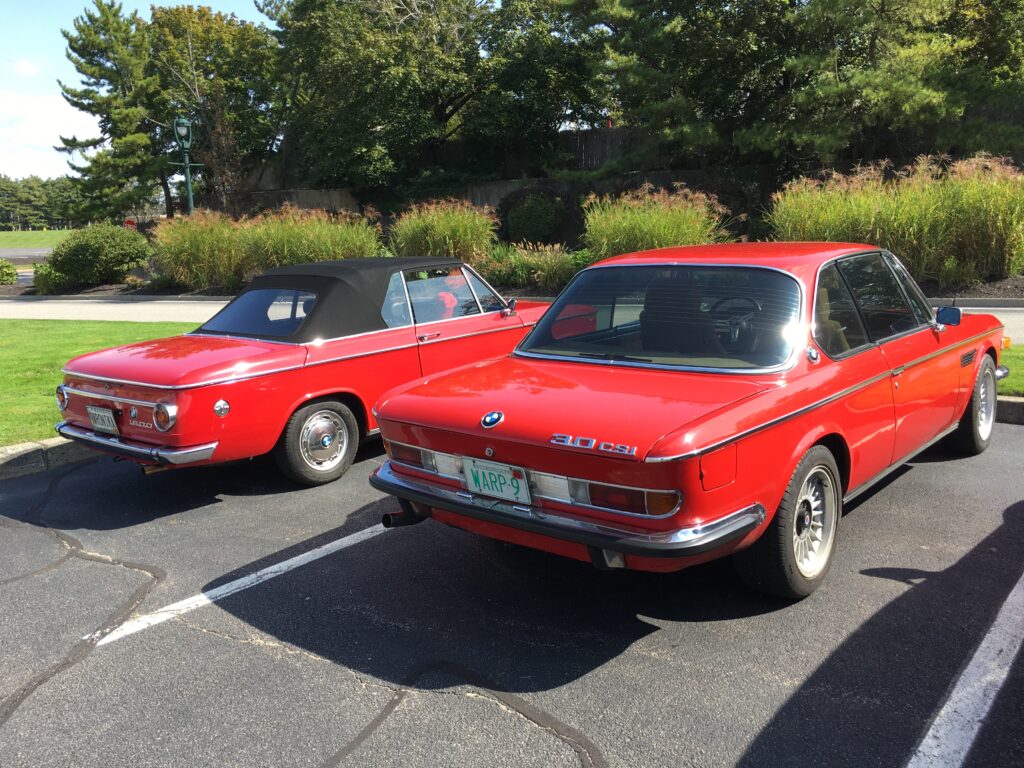
Rene parked at O’Fest next to my friend Andrew Wilson’s 1600 Voll cabriolet Veronika.
I’ve started Rene three times since getting home. The problem has not recurred. I’ll keep testing it, as I hope to drive the car to Vintage at Saratoga next weekend.
Who knows? Maybe more than two of my cars are quantum entangled. I’m thinking Nobel Prize.
And yes, from now on, when starting any car that’s been sitting, I’ll triple-check that the shifter is in neutral. Putting your foot on the clutch isn’t enough.
—Rob Siegel
____________________________________
Rob’s newest book, The Best of The Hack Mechanic, is available here on Amazon, as are his seven other books. Signed copies can be ordered directly from Rob here.

